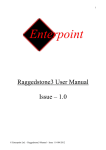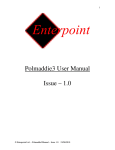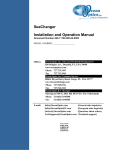Download XC3S3400A Coprocessor User Manual Issue – 1.0
Transcript
XC3S3400A Coprocessor User Manual Issue – 1.0 © Enterpoint Ltd. – XC3S3400A Coprocessor Manual – Issue 1.0 10/6/12 1 Programming Cable You will need a programming cable to connect between your PC and the XC3S3400A Coprocessor board. The Enterpoint PROG3 cable is recommended, or if you have a parallel port on your PC the Enterpoint PROG2 cable can be used. Foreword PLEASE READ THIS ENTIRE MANUAL BEFORE PLUGGING IN OR POWERING UP YOUR XC3S3400A COPROCESSOR BOARD. PLEASE TAKE SPECIAL NOTE OF ANY WARNINGS WITHIN THIS MANUAL. Trademarks Spartan-3A, ISE, Webpack, Xilinx are the registered trademarks of Xilinx Inc, San Jose, California, US. © Enterpoint Ltd. – XC3S3400A Coprocessor Manual – Issue 1.0 10/6/12 2 Contents Programming Cable Foreword Trademarks XC3S3400A Coprocessor Board Introduction Getting Started FPGA SPI FLASH DIL HEADERS LEDS CLOCK POWER CONNECTIONS POWER REGULATORS CONFIGURATION JUMPER SETTINGS PROGRAMMING XC3S3400A Coprocessor Mechanical Arrangement Medical and Safety Critical Use Warranty Support © Enterpoint Ltd. – XC3S3400A Coprocessor Manual – Issue 1.0 10/6/12 2 2 2 4 5 6 7 8 10 12 13 14 15 16 17 19 20 20 20 3 XC3S3400A Coprocessor © Enterpoint Ltd. – XC3S3400A Coprocessor Manual – Issue 1.0 10/6/12 4 Introduction Welcome to your XC3S3400A Coprocessor board. This board is primarily intended to extend the processing capabilities of any of the Enterpoint Xilinx based development boards, e.g. Raggedstone 1 and 2, Broaddown 2 and 4 or Drigmorn 2, 3 and 4. However it could also be used to extend the capabilities of a user's own board which has suitable headers and power supply arrangement. The aim of this manual is to assist in using the main features of XC3S3400A Coprocessor. There are features that are beyond the scope of the manual. Should you need to use these features then please email [email protected] for detailed instructions. XC3S3400A Coprocessor currently comes with a XC3S3400A-4CSG484CD Spartan-3A. A variant based on the XC3S1800A device may be offered at a later date or as an OEM product. Please contact out us on [email protected] should you need further information. © Enterpoint Ltd. – XC3S3400A Coprocessor Manual – Issue 1.0 10/6/12 5 Getting Started Your XC3S3400A Coprocessor will be supplied un-programmed. The Spartan-3A FPGA on board requires the full ISE toolset to develop and build a design. © Enterpoint Ltd. – XC3S3400A Coprocessor Manual – Issue 1.0 10/6/12 6 FPGA SPARTAN-3A FPGA The XC3S3400A Coprocessor supports Spartan-3A devices in the CSG484 package. It is normally available with commercial grade -4 speed devices fitted in the X3S3400A size. Should you have an application that needs industrial, faster speed grades please contact sales for a quote at [email protected]. © Enterpoint Ltd. – XC3S3400A Coprocessor Manual – Issue 1.0 10/6/12 7 SPI FLASH MEMORY 128M FLASH MEMORY The M25P128 SPI flash memory device U3 configures the FPGA when it is powered providing a suitable bitstream is programmed into the device. The M25P128 has a capacity of 128Mbits with a single configuration bitstream for XC3S3400A Coprocessor taking between 3.6Mbits (LX16) and 11.4Mbits (LX45). After configuration the SPI Flash can be accessed via the following pins of the FPGA: M25P128 FUNCTION CCLK MOSI DIN CSO_B FPGA PIN V17 V13 W17 U7 The WRITE and HOLD pins of this memory device are permanently connected to 3.3V. © Enterpoint Ltd. – XC3S3400A Coprocessor Manual – Issue 1.0 10/6/12 8 The M25P128 SPI flash memory device can also be accessed from a host board via pins RHS2 to RHS5 if the correct link is made on J5. Pin6 ISSUE 1.1 board Pin1 Fitting the link between pins 1 and 6 maps the SPI Flash signals as shown below: RHS DIL HEADER PIN 2 3 4 5 JTAG Signal DIN(U3 pin 2) MOSI(U3 pin 5) CSO_B (U3 pin 1) CCLK (U3 pin6) An adapter is available to facilitate the jumper settings on version 1.0 of this board. This is not necessary for version 1.1. © Enterpoint Ltd. – XC3S3400A Coprocessor Manual – Issue 1.0 10/6/12 9 DIL HEADERS The DIL Headers provide a simple mechanical and electrical interface for connecting the XC3S3400A coprocessor module to a supporting board. There are twenty I/O on each side of the DIL Header giving a total of 40 possible I/O. LEFT COLUMNS OUTER PINS INN ER S3 ROW FUNCTION PIN PINS 1 IO_L05N_0 AB6 0V 2 IO_L05P_0 AB5 0V 3 IO_L08N_2 AA8 0V 4 IO_L08P_2 AB7 0V 5 IO_L12N_2 AA10 0V 6 IO_L12P_2 AB10 0V 7 IO_L02N_1 AA22 0V 8 IO_L02P_1 Y21 0V 9 IO_L06N_1 Y22 0V 10 IO_L06P_1 W22 0V 11 IO_L14N_1 P22 0V 12 IO_L14P_1 R22 0V 13 IO_L28N_1 G22 0V 14 IO_L28P_1 H22 0V 15 IO_L37N_1 D22 0V 16 IO_L37P_1 D21 0V 17 IO_L1N_0 C19 0V 18 IO_L1P_0 D19 0V 19 IO_L7N_0 A19 0V 20 IO_L7P_0 B20 0V RIGHT COLUMNS OUTER PINS INNER S3 PINS FUNCTION PIN 3.3V IO_L04N_2 AA4 3.3V IO_L04P_2 AB4 3.3V IO_L35N_3 W1 3.3V IO_L35P_3 Y1 3.3V IO_L33N_3 V1 3.3V IO_L33P_3 U2 3.3V IO_L30N_3 U1 3.3V IO_L30P_3 T1 3.3V IO_L28N_3 R1 3.3V IO_L28P_3 R2 3.3V IO_L25N_3 P2 3.3V IO_L25P_3 P1 3.3V IO_L22N_3 N1 3.3V IO_L22P_3 M1 3.3V IO_L14N_3 J1 3.3V IO_L14P_3 H2 3.3V IO_L11N_3 H1 3.3V IO_L11P_3 G1 3.3V IO_L06N_3 F1 3.3V IO_L06P_3 F2 These DIL Headers can support up 20 pairs of LVDS signalling. The Spartan-3A FPGA can terminate any of these pairs as inputs. True differential output standards are supported only on FPGA banks 0 and 2. See Xilinx datasheet ds610.pdf available from www.xilinx.com . LVDS termination on individual signal pairs is a programmable option that can be set in build constraints for the FPGA when using the ISE toolset. The LVDS pairs are shown in the table above along with their bank numbers and the Spartan-3A pin numbers. © Enterpoint Ltd. – XC3S3400A Coprocessor Manual – Issue 1.0 10/6/12 10 The DIL Header connectors are arranged on a standard 0.1inch (2.54mm) pitch. This supports the use of prototype circuits using stripboard or other prototype materials. The horizontal pitch of the DIL Headers is 1.6 inches between the outer rows of the headers. The inner pins of the header form continuous power strips, one side header has an inner column of 3.3V pins. The other header has an inner column of DGND (0V). Note the voltage on each side of the header pins differs between issue 1.0 and issue 1.1 of this pcb ISSUE 1 3.3V ISSUE 1.1 0V 0V 3.3V Issue number © Enterpoint Ltd. – XC3S3400A Coprocessor Manual – Issue 1.0 10/6/12 11 LEDS LED3 LED2 LED1 XC3S3400A Coprocessor has 3 LEDs. These are arranged in a block to the left of the FPGA. The uppermost LED is Red, the centre one is Orange and the lowest one is green. The LEDS will turn on dimly when power is applied to the board. The relevant IO pin for an LED needs to be asserted high to ensure the specific LED turns on. The LEDS are connected to the FPGA as indicated below: LED 1 2 3 FPGA PIN M2 L1 L3 COLOUR GREEN ORANGE RED © Enterpoint Ltd. – XC3S3400A Coprocessor Manual – Issue 1.0 10/6/12 12 CLOCK It will be necessary for the user to arrange a clock source for the FPGA. If this board is plugged into an Enterpoint development board it is simply a case of routing the clock on that board to one of the IOs on the DIL headers supporting this module. Alternatively a 3.3V oscillator can be connected to one of the input pins from your own circuitry. © Enterpoint Ltd. – XC3S3400A Coprocessor Manual – Issue 1.0 10/6/12 13 POWER CONNECTIONS The XC3S3400A Coprocessor is powered principally from the host board. The Coprocessor board should be plugged into 0.1mm pitch DIL headers on a host pcb. The host power supply must be capable of supplying at least 1A at 3.3V to the Coprocessor module. The actual power supply requirements are dependent upon the demands of the IOs which operate from the 3.3V supply, and the design in the processor core, which operates at 1.2V. A demanding design running at high speed will require more power at 1.2V (up to 4A) than a simple design running at lower speeds. Whatever power supply is used care should be taken not to exceed 5.4V input as this will cause damage to the XC3S3400A Coprocessor. PLEASE NOTE THAT TO USE THE 1.0 VERSION OF THIS BOARD IN CONJUNCTION WITH STANDARD ENTERPOINT BOARDS WILL REQUIRE IT TO BE PLUGGED IN UPSIDE DOWN. CHECK THE PINOUTS OF EACH BOARD. © Enterpoint Ltd. – XC3S3400A Coprocessor Manual – Issue 1.0 10/6/12 14 POWER REGULATOR 1.2V REGULATOR A Micrel MI22600 regulator supplies 1.2V with a maximum current available of 6A (In practice this may be limited by the power available from the 3.3Vsupply from the host board). WARNING – REGULATORS CAN BECOME HOT IN NORMAL OPERATION ALONG WITH THE BOARDS THERMAL RELIEF. PLEASE DO NOT TOUCH OR PLACE HIGHLY FLAMABLE MATERIALS NEAR THESE DEVICES WHILST THE XC3S3400A Coprocessor BOARD IS IN OPERATION. © Enterpoint Ltd. – XC3S3400A Coprocessor Manual – Issue 1.0 10/6/12 15 CONFIGURATION JUMPER SETINGS The XC3S3400A module can be programmed in two ways. The first is to use the JTAG connector J2, which is a 7x2 2mm Right angled shrouded male header. Alternatively the JTAG connections can be accessed from the host board via the DIL header pins. Using this approach some of the IO on the DIL header will be unavailable while configuration is taking place. Jumper J5 is used to select whether the JTAG signal source is the connector J2 or the DIL headers pins RHS2 to RHS5 ISSUE 1.1 board Pin4 Pin3 J5 LINK None Pins 3 to 4 JTAG SOURCE J2 RHS2 to RHS5 Fitting the link between pins 3 and 4 maps the JTAG signals as shown below: RHS DIL HEADER PIN 2 3 4 5 JTAG Signal TDI TDO TCK TMS An adapter is available to facilitate the jumper settings on version 1.0 of this board. This is not necessary for version 1.1. © Enterpoint Ltd. – XC3S3400A Coprocessor Manual – Issue 1.0 10/6/12 16 Programming XC3S3400A Coprocessor The programming of the FPGA and SPI Flash part on XC3S3400A Coprocessor is achieved using the JTAG interface. There is a single JTAG chain on XC3S3400A Coprocessor. The JTAG chain allows the programming of the Spartan-3A and SPI Flash device. The JTAG connector has a layout as follows (top view): 3V3 GND TMS GND TCK GND TDO GND TDI GND NC GND NC GND Using iMPACT Boundary Scan the JTAG chain appears like this: 1. Programming the FPGA directly. Direct JTAG programming of the Spartan-3A FPGA is volatile and the FPGA will lose its configuration every time the board power is cycled. For sustained use of an FPGA design programming the design into the Flash memory is recommended (see 2 and 3 below). Direct JTAG programming using .bit files is useful for fast, temporary programming during development of FPGA programs. Right click the icon representing the Spartan-3A FPGA and choose ‘Assign New Configuration File’. Navigate to your .bit file and choose ‘OPEN’. The next dialogue box will offer to add a flash memory and you should decline. Right click the icon representing the Spartan-3A FPGA and choose ‘Program’. On the next dialogue box ensure that the ‘Verify’ box is not checked. (If it is you should uncheck it, failure to do this will result in error messages being displayed). Click OK. The Spartan-6 will program. This process is very quick (typically one second) © Enterpoint Ltd. – XC3S3400A Coprocessor Manual – Issue 1.0 10/6/12 17 2. Programming the SPI flash memory using Boundary Scan. Once the SPI Flash memory has been programmed, the Spartan-3A device will automatically load from the Flash memory at power up. Generation of suitable Flash memory files (.mcs) can be achieved using ISE iMPACT’s Prom File Formatter. Right click on the icon representing the Spartan-3A and choose ‘Add SPI/BPI Flash’ Navigate to your programming file (.mcs) and click OPEN. Use the next dialogue box to select SPI flash and M25P128. Data width should be set to 1. The flash memory should appear as shown below. Right click on the icon representing the flash memory and choose program to load your program into the device. It is recommended that options to ‘Verify’ and ‘Erase before programming’ are chosen. Otherwise all defaults can be accepted. The programming operation will take some time (at least 3 or 4 minutes) © Enterpoint Ltd. – XC3S3400A Coprocessor Manual – Issue 1.0 10/6/12 18 MECHANICAL ARRANGEMENT The Dimensions on the drawing below are millimetres (mm). All sizes quoted are subject to manufacturing tolerances and should only be used as a general guide. The height of the highest components (the header pins), measured from the lower surface of the board, is approximately 7mm. © Enterpoint Ltd. – XC3S3400A Coprocessor Manual – Issue 1.0 10/6/12 19 Medical and Safety Critical Use XC3S3400A Coprocessor boards are not authorised for the use in, or use in the design of, medical or other safety critical systems without the express written person of the Board of Enterpoint. If such use is allowed the said use will be entirely the responsibility of the user. Enterpoint Ltd will accepts no liability for any failure or defect of the XC3S3400A Coprocessor board, or its design, when it is used in any medical or safety critical application. Warranty XC3S3400A Coprocessor comes with a 90 day return to base warranty. Do not attempt to solder connections to the XC3S3400A Coprocessor. Enterpoint reserves the right not honour a warranty if the failure is due to soldering or other maltreatment of the XC3S3400A Coprocessor board. Outside warranty Enterpoint offers a fixed price repair or replacement service. We reserve the right not to offer this service where a XC3S3400A Coprocessor has been maltreated or otherwise deliberately damaged. Please contact support if you need to use this service. Other specialised warranty programs can be offered to users of multiple Enterpoint products. Please contact sales on [email protected] if you are interested in these types of warranty, Support Telephone and email support is offered during normal United Kingdom working hours (GMT or GMT + 1) 9.00am to 5.00pm. Telephone - +44 (0) 121 288 3945 Email - [email protected] © Enterpoint Ltd. – XC3S3400A Coprocessor Manual – Issue 1.0 10/6/12 20

























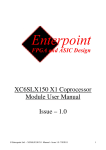
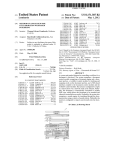

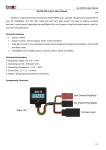


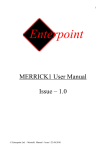


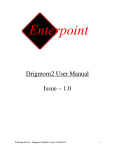
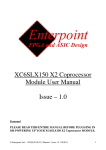
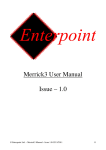
![Atari ST System-on-Chip in VHDL (Author: Lyndon Amsdon) [undated]](http://vs1.manualzilla.com/store/data/005994841_1-cb1a0817df59f22c671df08194997a7c-150x150.png)
